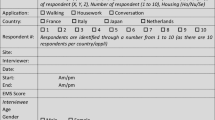Abstract
The present study explored a workshop method including questionnaires but also creative, implicit methods as a new way of uncovering users’ implicit concepts of a helper and supporting creative answers by users. Eight older (70+) and ten younger (<70) participants collaborated in the workshops. They filled in a questionnaire and completed a picture association activity as well as a creative modelling unit. The word ‘robot’ was not used in the entire workshops to prevent users from directly thinking of robot stereotypes. Results demonstrated that picture associations cause a higher amount of answers regarding features of a ‘helper’ than direct questionnaire items. These results can be translated to the field of social robotics. According to the findings, users preferred a structure of the helper that featured arms, some kind of body and a head they could talk to. Most of all, picture associations played an important role in revealing the individual concepts of users. These results suggest that the method of implicit questioning is a useful additional approach in the assessment of user requirements and human-robot-interaction research.
Access this chapter
Tax calculation will be finalised at checkout
Purchases are for personal use only
Preview
Unable to display preview. Download preview PDF.
Similar content being viewed by others
References
European Commission–Eurostat: Key figures on Europe 2007/2008 edition. Luxembourg: Office for Official Publications of the European Communities (2008)
Dias, N., Kempen, G., Todd, C.J.: The German version of the Falls Efficacy Scale- International Version (FES-I). Gerontol Geriatr 39, 297–300 (2006)
Goodrich, M.A., Schulz, A.C.: Human-robot interaction: a survey. Foundations and Trends in Human-Computer Interaction 1(3) (2007)
Dillon, A.: User acceptance of information technology. In: Karwowski, W. (ed.) Encyclopedia of Human Factors and Ergonomics. Taylor and Francis, London (2001)
Lee, M.K., Forlizzi, J., Kiesler, S., Rybski, P., Antanitis, J., Savetsila, S.: Personalization in HRI: A longitudinal field experiment. In: HRI 2012 Proceedings of the Seventh Annual ACM/IEEE International Conference on Human-Robot Interaction, pp. 319–326 (2012)
Heinecke, A.M.: Mensch-Computer-Interaktion Basiswissen für Entwickler und Gestalter, 2nd edn. Springer, Berlin (2012)
Vincenzi, C., Spirig, R.: Die Bedürfnisse der Patienten stehen im Mittelpunkt. Managed Care 8, 12–14 (2006)
Lammer, L., Huber, A., Zagler, W., Vincze, M.: Mutual-Care: Users will love their imperfect social assistive robots. Work-In-Progress Proceedings of the International Conference on Social Robotics 2011, Amsterdam, the Netherlands, November 24- 25 (2011)
Lee, S., Lau, I., Kiesler, S., Chiu, C.: Human Mental Models of Humanoid Robots. In: Proceedings of the IEEE International Conference on Robotics and Automation (2005)
Heerink, M., Kröse, B., Evers, V., Wielinga, B.: Relating conversational expressiveness to social presence and acceptance of an assistive social robot. Springerlink 14(1), 77–84 (2009)
Kuo, I.H., Rabindran, J.M., Broadbent, E., Lee, Y.I., Kerse, N., Stafford, R.M.Q., MacDonald, B.A.: Age and gender factors in user acceptance of healthcare robots. The University of Auckland, New Zealand (2009)
Beer, J.M., Smarr, C.A., Chen, T.L., Prakash, A., Mitzner, T.L., Kemp, C.C., Rogers, W.A.: The domesticated robot: design guidelines for assisting older adults to age in place. In: HRI 2012 Proceedings of the Seventh Annual ACM/IEEE International Conference on Human -Robot Interaction, pp. 335–342 (2012)
Hirsch, T., Forlizzi, J., Hyder, E., Goetz, J., Kurtz, C., Stroback, J.: The ELDER project: social, emotional, and environmental factors in the design of eldercare technologies. In: CUU 2000 Proceedings on the 2000 Conference on Universal Usability, pp. 72–79 (2000)
Wu, Y.H., Fassert, C., Rigaud, A.-S.: Designing robots fort he elderly: appearance issue and beyond. Archives of Gerontology and Geriatrics 54, 121–126 (2012)
Oestreicher, L., Severinson-Eklundh, K.: User Expectations on Human-Robot Cooperation. In: The 15th IEEE International Symposium on Robot and Human Interactive Communication, pp. 91–96 (2006)
Meyer, S.: Mein Freund der Roboter. Servicerobotik für ältere Menschen - eine Antwort auf den demographischen Wandel? Institut für Sozialforschung und Projektberatung GmbH, Berlin (2011)
Riessman, F.: The ’helper’ therapy principle. Social Work 10(2), 27–32 (1965)
Paro Therapeutic Robot, http://www.parorobots.com
Murray, H.A.: Thematic Apperception Test. Harvard University Press, Cambridge (1943)
Broadbent, E., Tamagawa, R., Kerse, N., Knock, B., Patience, A., MacDonald, B.: Retirement home staff and residents’ preferences for healthcare robots. In: The 18th IEEE International Symposium on Robot and Human Interactive Communication, RO- MAN, pp. 645–650 (2009)
Mason, M., Lopes, M.: Robot self-initiative and personalization by learning through repeated interactions. In: HRI 2011 Proceedings of the 6th International Conference on Human-Robot Interaction, pp. 433–440 (2011)
Broadbent, E., Lee, Y.I., Stafford, R.Q., Han Kuo, I., MacDonald, B.A.: Mental Schemas of Robots as more Human-like are associated with higher blood pressure and negative emotions in a human-robot interaction. International Journal of Social Robotics 3(3), 291–297 (2011)
Author information
Authors and Affiliations
Editor information
Editors and Affiliations
Rights and permissions
Copyright information
© 2012 Springer-Verlag Berlin Heidelberg
About this paper
Cite this paper
Körtner, T. et al. (2012). How Social Robots Make Older Users Really Feel Well – A Method to Assess Users’ Concepts of a Social Robotic Assistant. In: Ge, S.S., Khatib, O., Cabibihan, JJ., Simmons, R., Williams, MA. (eds) Social Robotics. ICSR 2012. Lecture Notes in Computer Science(), vol 7621. Springer, Berlin, Heidelberg. https://doi.org/10.1007/978-3-642-34103-8_14
Download citation
DOI: https://doi.org/10.1007/978-3-642-34103-8_14
Publisher Name: Springer, Berlin, Heidelberg
Print ISBN: 978-3-642-34102-1
Online ISBN: 978-3-642-34103-8
eBook Packages: Computer ScienceComputer Science (R0)




